|
CHRISTMAS, 2022 :
'TRANSFORMATIONS FROM THE EARTH, & SANDS' :
'CERAMICS', &
'GLASS'
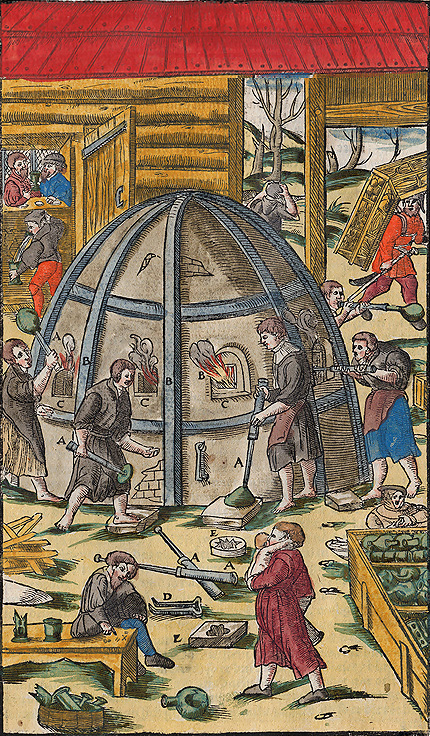
PART II
/
'FROM THE SANDS' :
GLASS
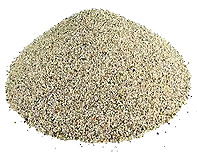 |
Early glass was about two-thirds
SILICA SAND,
the balance, lime and soda ash
|
It is said that c5000 BC, the first glass was produced accidentally,
when heat from a fire melted rocks, mixed them with 'sand', and voila :
'MOLTEN GLASS'!
Early glassmaking, though costly, existed throughout the Eastern and
Mid East cultures, in Africa, Greece - and flourishing in Rome.
With the fall of the Roman Empire, glassmaking, particularly glass-blowing, waned in Europe.
Venice was the exception,
their glassmaking continuing as a major industry,
which they transferred - along with its 'secrets' -
in 1291 to the island of Murano.
In the 1400s Murano developed 'cristallo' (in imitation of rock crystal),
nearly colorless, superb as a 'drinking glass', and prizedthroughout Europe.
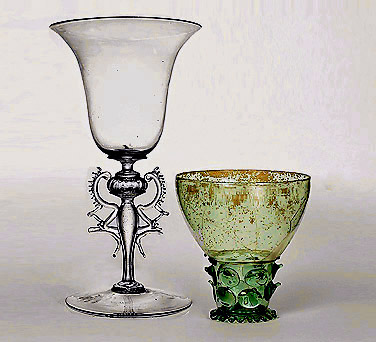
Above, a 15th century Venetian 'Cristallo' Wineglass, with a contemporary German Roemer.
In the 1500s, glass began to regain importance
throughout Europe, particularly in Germany.
And in the late 1500s, England hired
Venetian glassblowers
to make glassware, in England,
including small mirrors, window glass
and a few 'drinking glasses'.
|
|
Right : "Glass-blowers", from a 15th century
Italian Manuscript, British Library, Sloane Collection |
Around 1663, England's glassmaker George Ravenscroft developed
a colorless translucent glass with many properties
desirable for working the 'drinking glass'.
This process was perfected by 1676,
and by 1700, 'lead glass' - particularly as 'drinking glasses'
helped to propel England to the front of the glass industry –
even superior to Murano.
Below are a few examples of British 'lead glass' from our stock,
( which dates from c1700 to c1820 )
including drinking glasses, accessories and other fineries.
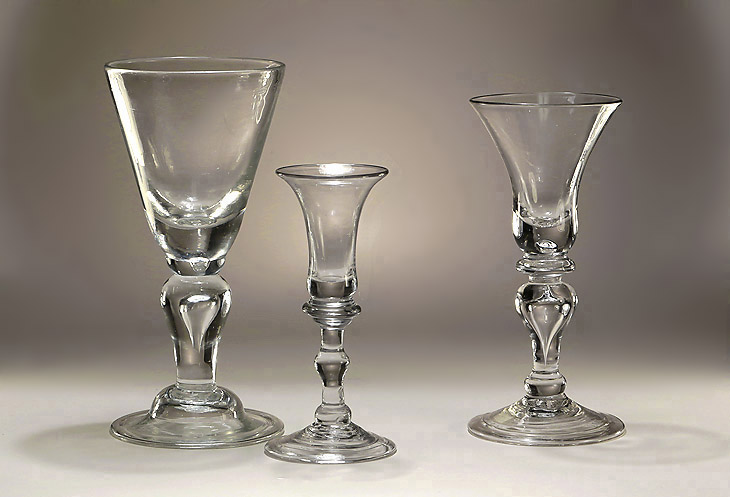
William III / Queen Anne Heavy Baluster Goblet, England, c1700-1710
England, c1700-1710, 7.5" High
An almost identical goblet is illustrated, "Investing in Georgian Glass", (Ward Lloyd, p.38) :
"A good early baluster goblet dating from about 1700.
The round funnel bowl has a slight extrusion in the base,
the stem is an inverted baluster and the foot is domed and folded."
George I / II
Baluster Cordial or Gin Glass
England, c1720-30, 5.5" High
With good grey color, the bell bowl with solid base above a solid stem
headed by a 3-ringed annular knop over a central ball knop and flattened basal knop,
raised on a round and folded foot; these small glasses are "uncommon"
George I Two-Teared Baluster Wine Glass, c1720
England, c1720, 6.5" High
with teared inverted baluster stem, considered the 'most comfortable' to hold in the hand.
Provenance : 'The Harding Collection', Sotheby's London
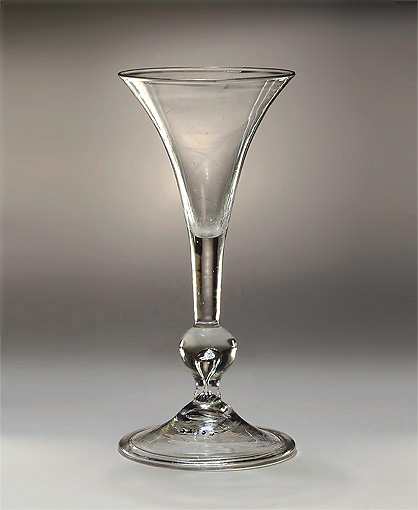
George II 'Kit-Cat' Type Wineglass, England, c1730, 6-5/8' High
Glasses of this form - with plain stem and central or lower baluster
are often referred to as 'Kit-Cat' glasses,
referring to glasses depicted in Sir Godfrey Kneller's c1721 painting of two members of the 'Kit-Cat Club',
London dining society which began meeting in the 1690s. (See 'Footnotes' for more).
'WHEEL ENGRAVING' on British drinking glasses
became established in the second quarter of the 18th century.
The 17th century baroque formalism of Continental engraving gave way to a 'decorative naturalism',
depicting almost anything from the English garden, and sometimes referred to as 'flowered glasses'.
Evidence suggests that the early English wheel engraving emanated from London,
spreading to the provinces about 1750.
It is into this 'naturalistic' fashion, c1740-60,
that the floral and insect engraving of 'Jacobite' drinking glasses emerged :
'Jacobite' engraving featuring cryptic 6-petaled roses, daffodils, carnations, tulips and sunflowers,
as well as symbolic moths, birds and bees.
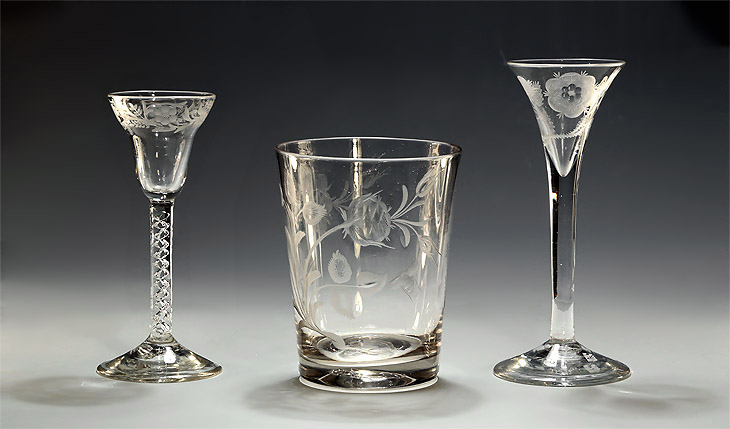
George II Engraved Pan-Topped 'Mercury Twist' Wine Glass, England, c1750
each side with a 4- and 6-petalled flowers and fern-like foliage (possibly a Scottish rose)
Rare Large George III 'Jacobite' Interest Engraved Glass Beaker, England, c1765-75,
with 2 multi-petaled Stuart roses, each issuing two rosebuds, the reverse with three bees in flight
George II 'Jacobite' Drawn Trumpet Wine Glass, England, c1750,
a Stuart Rose sided by an open bud, and a closed bud
Following closely on the heels of the early baluster 'drinking glass' was
'THE CLEAR GLASS DECANTER' :
Late 17th and early 18th century 'serving bottles' were made from dark heavy mould-blown glass.
A parchment label, attached with string, identified the 'mysterious' contents.
Between 1720 and 1730, a group of carafes were introduced,
known as "cruciform decanters".
They were followed by labels in silver, bearing the names of the contents.
the earliest in a cartouche or 'escutcheon' form.
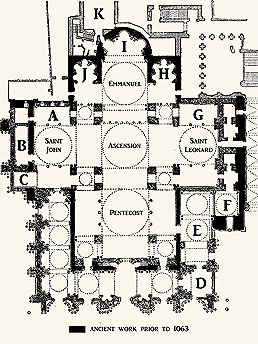 | 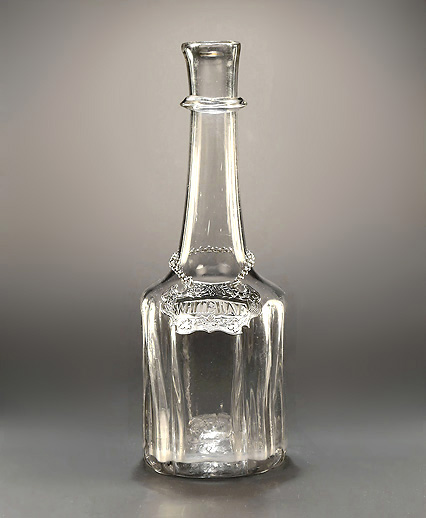 |
Byzantine Cruciform Floor Plan,
St. Mark’s Basilica,
Venice, Italy |
| |
George II Cruciform Glass Decanter, England, c1730, 9.5" High
Shown with a
Rare George II Silver 'Escutcheon' Bottle Ticket, 'WHITE WINE'
William Cripps, London, 1743-50
(Rounded decanters with fitted stoppers - that we all now know - emerged about 1750).
The dark moulded bottles of the 17th and early 18th century
continued in use well into the 19th century, existing in various shapes and sizes.
Among the most collectible of these colored bottles is the
"SEALED BOTTLE".
The English practice of adding 'seals' to glass bottles dates to the 17th century.
In 1622, a law was passed prohibiting the sale of wine by the bottle.
Thus 'gentlemen of wealth', taverns, universities and organizations
would necessarily take their bottles to the merchant to be filled.
The process of adding a seal to a bottle was quite expensive.
It involved attaching a small blob of glass whilst it was warm,
then stamping it with a metal or ceramic die.
Due to these seals, it is possible to track many back to their original owners.
Two Dark Green Glass ‘Sealed’ Cylinder Wine Bottles
England, c1800 & c1820, Both 'Cornwall Interest'
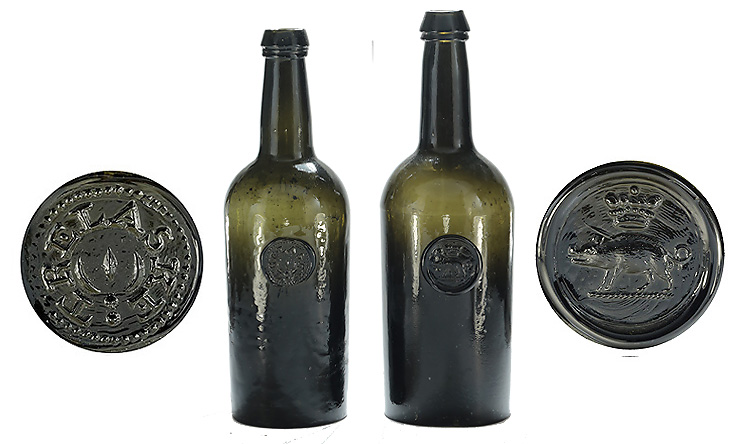
With Seals for 'Trelaske', Lewannick, Cornwall, 10.75" High (left)
and the 'Edgcumbe Family', Cornwall and Devon. 11.5" High (right)
'LIGHTING' : Candlesticks and Tapersticks
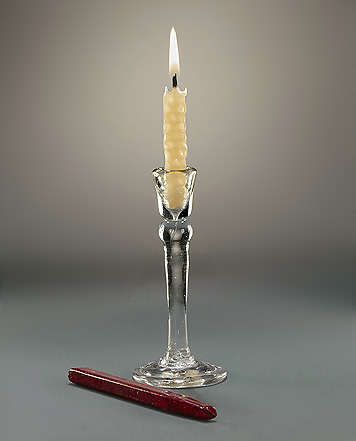 |
|
Below : Edward Collier, active 1662-1708:
"Trompe-l'œil" of a letter rack,
including a writing quill, and a stick of
vermillion sealing-wax for sealing letters |
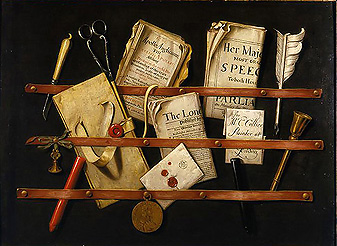
|
Rare George I Glass Taperstick
England, c1720, 4.25" High
The heavy walled bowl over a 'tapering baluster' stem,
applied terraced folded foot and rough pontil
A rare and early example, intended for heating sealing wax for letters
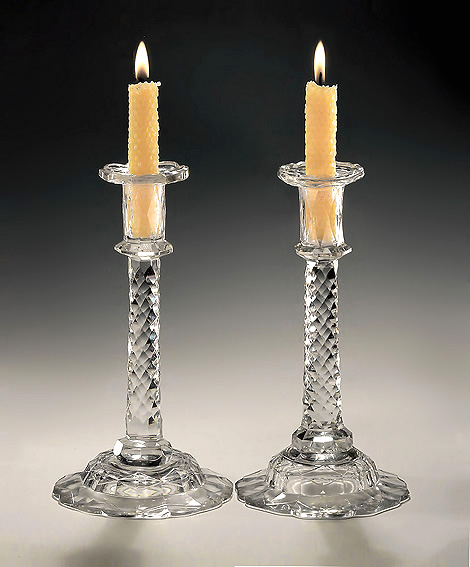
Pair of George III Flat Cut Glass Candlesticks, England, c1760-70
England, c1760-70, 10.5" High
Of fine quality, flat-cutting and weight, 52.4 oz (4 lbs. 4.4 oz.)
'THE TAZZA' :
In the 1500s, Murano had also made, in 'Cristallo', shallow-bowled 'tazzas',
so frequently shown in 16th Netherlandish century paintings.
The British Isles introduced 'glass tazzas,'
or 'footed salvers', c1730, with a flatter rimmed dish.
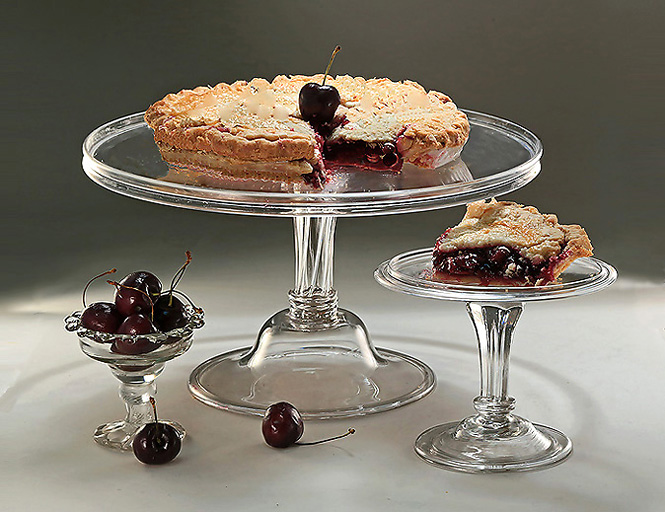
George III Glass Tazza with Domed Foot and Twist Stem, 12" Wide, Mid 18th Century
George III Small Glass Tazza with Pedestal Stem, 6" Wide, Mid-Late 18th Century
George II Glass Sweetmeat Dish, Twist Stem and Oversewn Foot, c1750
All awaiting the 'Christmas Cherry Pie'!
WISHING YOU 'CHEER' & 'CHERRIES'
THROUGHOUT THE HOLIDAY SEASON!
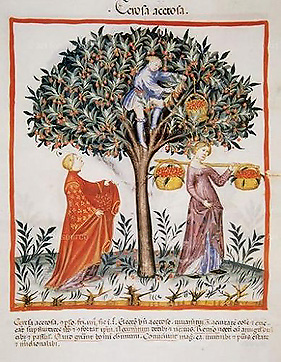
"Then Mary spoke to Joseph
So meek and so mild :
'Joseph, gather me some cherries,
For I am with child'"
From this ancient earth, its skies, seas and sand
Comes all that we know - even made by man's hand.
It is with awe, on this surface, I stand.
MERRY CHRISTMAS !!
Millicent Creech
Footnotes, Referenced in Order of Appearance :
Top : "Glass Furnace, with Workers", c1580, Georg Agricola (German, 1494–1555).
Carnegie Museum of Glass; Creative Commons
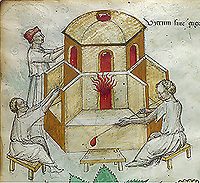
"Glass Blowers" (above), 15th Century Italian Manuscript, British Library Sloane Collection
To British ceramic collectors, Sir Hans Sloane (1660-1753) is well known for his botanical gardens
in Chelsea, and the prized Chelsea porcelains painted from the many specimens therein.
Sloane also amassed a vast collection of manuscripts, covering a wide range of subject matter: medicine,
chemistry, botany and horticulture, exploration and travel, mathematics and natural history, magic and religion.
This collection was purchased at Sloane's death by the Act of Parliament
which also established the British Museum.
The collection represents one of the three foundation collections of the British Library.
For more and an enlargement of the illumination page, click here
( MS 4016, f. 101v DQ8LFB3XkAAkyF8 ), Public Domain
'Kit-Cat Club' - the London dining society owned by Christopher Cat :
Cat purportedly gave his name to the mutton pies known as "Kit Cats",
from which the name of the club is possibly derived.
Between 1700 and 1720, member and portraitist Godfrey Kneller painted each of the 42 members,
these portraits now hanging in the National Portrait Gallery, London.
Byzantine Cruciform Floor Plan, St. Mark’s Basilica, Venice, Public Domain
"Trompe L'oiel with Writing Materials", Edward Collier, active 1662-1708 ;"
Trompe-l'œil" is French meaning "deceive the eye".
It is a painting technique so expertly executed that the objects appear real and three-dimensional.
Creative Commons
"Tacuinum Sanitatis", Manuscript, 14th Century, 'Tart Cherry' (Prunus cerasis) folio 12r.
Unknown author, Wikimedia, Public Domain
The 'original' version of the "Cherry Tree Carol" dates to the Middle Ages.
It appears in a set of Bible-based "Mystery Plays" knowntoday as the "N-Town Plays",
performed in the English Midlands around 1500.
(Below : "Hands at the Cuevas de las Manos upon Río Pinturas"
(Perito Moreno, Santa Cruz Province, Argentina)
Image : Creative Commons
Inventory Photography : Millicent F. Creech
To RETURN to
Part I of 'Transformations From The Earth & Sands'
Ceramics & Glass
please click here or the image below
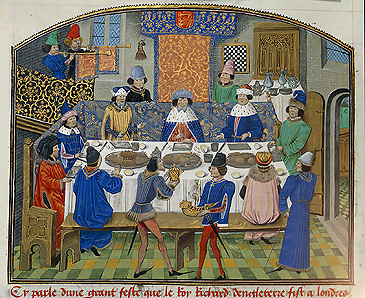
Also In Our CHRISTMAS 2022 ,"TRANSFORMATIONS" Series :
'From The Forests' (Timber) :
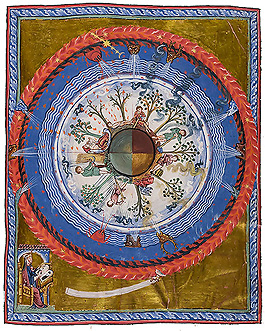
'From The Mountains' (Silver) :
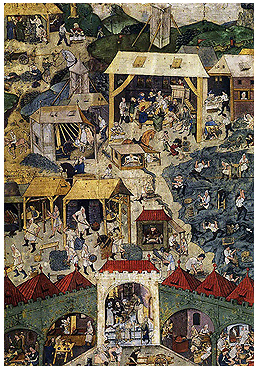 ' '
'From The Human Spirit' (Fine Art) :
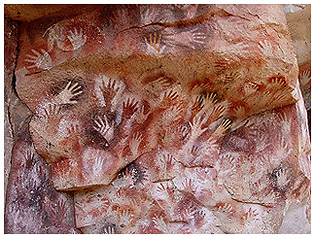
|